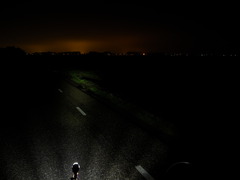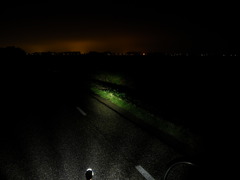LED light colour, CRI and experiments (in fog and on various road surfaces)
The experiments on this page are in particular meant to see what is the best light colour of LEDs for bicycle headlamps. But there are some other experiments to do with how far a headlamp should be from your eyes in case of fog, and more.
Contents
Updates
Pocket lamps and LEDs that I use in 2024
I only use high CRI LEDs these days. I gave away or sold a few lights such as the D4V2 with Nichia 219C sw45k. This puts out light of about 4500K with slightly negative DUV, so looks slightly rosy, this has interesting plus points but 4500K is too cool, it is absolutely not optimal and not useful in the rain on unlit roads as I experienced in a blacked out Kharkov on a rainy night in 2022.
I have (LEDs can differ from specification, I too the average of many measurements that people published on budgetlightforum to estimate what you can expect from a given LED)):
- Old S2+ with Cree XML 4C (ca. 4200-4500K) [ CRI according to Cree ca. 75 ]
- S3 with Nichia 519A 3000 K [ in reality: ca. 3000 K ], CRI 95+
- S2+ with Nichia 519A 3500 K [ in reality: ca. 3350 K ], CRI 95+
- S2+ with Nichia 519A 4000 K [ in reality: ca. 3800 K ], CRI 95+
- S2+ with Nichia 519A 4500 K [ in reality: ca. 4200 K ], CRI 95+
- S2+ with Nichia 519A 5700 K [ in reality: ca. 5400 K ], CRI 95+
- Sofirn SC31 pro modified with TIR lens and Nichia 519A 4000K sliced to 1.30mm [ should be about 3600K, and is slightly rosy ], CRI 95+ my favourite at the moment
- Sofirn SC31 pro modified with TIR lens and Nichia 519A 4500K sliced to 1.26mm [ should be about 4000K, and is slightly rosy ], CRI 95+
- FC11 modified with SST20 4000K (not greenish, absolutely neutral, from Convoy), CRI 95+
- Jaxman E2L, came with triple 219C 4000K (CRI 90+) which I didn't like, replaced with triple SST20 4000K from Kaidoman, these were a bit green, so I am going to replace those as well, probably with 519As...
For information on slicing the 519A LED, see https://budgetlightforum.com/t/519a-try-slicing/70295.
Older pocket lamps and LEDs that I used:
Pocket lamps that I bought around 2009-2010 usually came with cool white Cree LEDs:
- Cree specified CRI for LEDs from that time as being about 65 for LEDs that are from 5000 K to 8000 K.
I modified a few lamps:
- I used for example an XP-G 5B1 from Cutter which is pretty good. CRI of this LED was specified as 70 minimum.
The LFT2XT used a Cree XP-E which from comparisons may have been the F6 (3750 K), otherwise the Z5 (4000K). CRI specified by Cree is 75 typical, and there was a CRI 80 version.
The XM-L E5 is 4000K with 80+ CRI.
0. LED colour ranges: Warm, neutral and cool white
Definitions vary a bit in where exactly lie the borders between warm and neutral white and cool white, and the definition of what is cool white in LEDs is different from the use of what is cool white in incandescent lighting. For LEDs the ranges are approximately:
- Warm white: Up to ca. 3500K
- Neutral white: ca. 3500K-5000K (my experiments showed that the 5B and 4C Cree LEDs are about optimal in seeing everything properly, so a colour temperature of about 4000-4400K, see further on )
- Cool white: more than 5000K
1. LED colour comparison in the garden: Neutral white vs. cool white
The colour usually chosen for LED bicycle lamps is cool white because that is the type of colour LED makers can produce most light output with, i.e. this is a 'bigger is better' choice, but it's more complicated than that. Neutral or warm white give better colour rendition for those colours that one sees at the edge of the paved road, and for mountain biking this means obviously a better colour rendition on the entire 'trail'.
Here is a picture of a bit of green in the garden:

About the same position, but at night, illuminated using a torch with cool white LED (F23, with Cree XP-E, LED colour WC [ addition 2020-2-12 This older colour name used at that time by Cree, around 2010, is somewhere in the region 6350K-7000K ]:
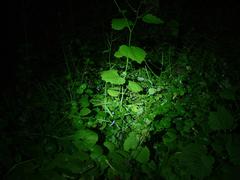
The same position as before, again at night, illuminated using a torch with neutral white LED (Liteflux LF2XT, with Cree XP-E, LED colour 4C ):
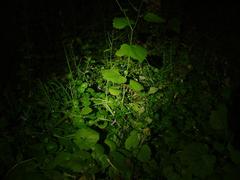
Did you notice the purple flowers in the first picture? Did you notice them in the last picture? A few weeks ago these flowers were more blue than purple as they are now, and at that time the flowers suddenly jumped out at night when I used the cool white LED light. During the day they were inconspicuous. This means blue is accentuated much more than other colours giving a view that's quite different from what you experience in daylight. Even more so because blue doesn't appear much in nature! When you look at the above pictures, these flowers don't jump out as much as they did before (of which I unfortunately didn't make photographs), but they do appear more bluish and they stand out more. Also, you can see the picture from the cool white LED is bland; all the greens sort of look alike and the whole scene looks flat, without depth. Now look at the picture with the neutral white LED. You now see the greens are all different, with various bits of yellow/brown which hardly show up in cool white light. For mountain biking in particular, neutral white is much better than a cool white light. But for road riding too, neutral white gives better colour rendition of the colours you will encounter in grass on the side of the road, trees far ahead etc.
Final example of the same small flowers (but in another spot in the garden) 2 weeks later. Their colour now is near violet, and with a cool white torch, they look to be a pale blue. Using the neutral white torch, the real colour shows...
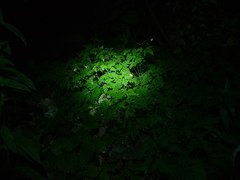
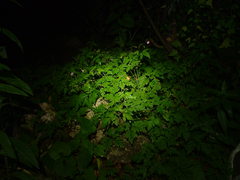
2. LED colour comparison on various road surfaces: cool, neutral and warm white LEDs
After seeing the difference that neutral and cool white gave in my garden, I began experimenting more to see what changing the LED colour brings to a bike lamp by using a few torches as bike lamps and doing other experiments with them.
Here's a ANSI white colour graph (for Cree LEDs, as those are the ones I test with):
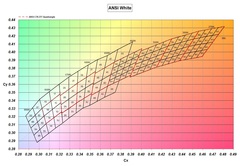
And here are the torches I experiment with, from left to right:
- (1) Trustfire XP-E F23: XP-E (stated as R2, but more probably Q3 or somewhere in that region) LED, WC which is about 0D to 1A in the ANSI white chart, which is cool white (in the picture below it appears very bluish which I don't experience when using the torch).
- (2) Liteflux LF2XT: XP-E Q4 LED, colour 4C (colour temperature 4200-4500K ) which is neutral white.
- (3) Trustfire XP-E F23 that I modified with an XP-G R4 colour 5B1 which is neutral white (note that it's a bit more green than the previous torch. You can also see in various beam shots below that it has a much wider hotspot than torch 1 but it also puts out more light in total due to the XP-G R4).
- (4) Trustfire XP-E F22 that I modified with an XP-G Q4 colour 8B1 which is warm white.
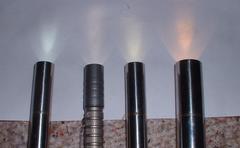
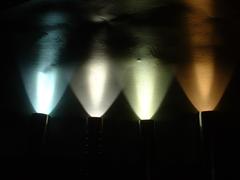
2.1. Colour comparison test on dry asphalt using torches
General impression: Neutral white is probably the best as it gives a more agreeable colour for opposing traffic, more depth in the objects you see on the side of the road (i.e. not all the greens becoming one green ocean, and yellow/brown colours are visible instead of almost gone as they are with cool white). For the roads themselves the colour doesn't matter that much, although warm white gives much better results under certain circumstances (road types), depending of course on colour/composition of the road surface.
2.2. Colour comparison test on wet asphalt using torches
A brief first test I did wasn't conclusive although I think the more warm the light, the better (and less annoying to oncoming traffic) it is under all circumstances (this is only true for the asphalt road itself, not the green beside it, as you can see from other experiments I did and pictures I made)
Another test done on wet asphalt, including sections where a shallow layer of water was laying on it, with the following road types: rough asphalt, new smooth dark asphalt, and the reddish variety that's often used for bicycle paths. From all the above torches I prefer the Liteflux's colour (i.e. 4C ). It gives better rendition of the colours on the road than the XP-G 5B1, much better than the cool white WC one. Warm white is perhaps slightly better but not enough to offset the large drop in efficiency. So in wet conditions 4C seems an excellent choice. Pictures to be made at a later date.
The following pictures were made a lot later on 28 October 2010, the same day I made beam shots of the Frankenlamp with XP-G modification, i.e. on a wet road 2, with torches using:
(1) XP-E WC cool white, (3) XP-G R4 5B1 neutral white, (4) XP-G Q4 8B1 warm white:
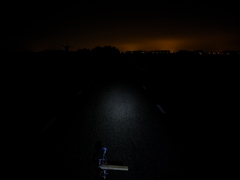
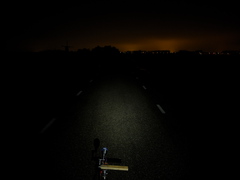
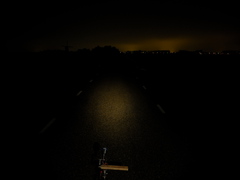
(14 M pixel images)
Note that these pictures were made as an afterthought, so I want to make a systematic set of pictures on various road surfaces at a later date.
2.3. LED light colour tests on wet asphalt on a bicycle: Neutral white (XP-G R4 5B1 in modified Lumotec a.k.a. the Frankenlamp) vs. cool white (Edelux)
Lamps used: 1. Frankenlamp, LED XP-G R4, colour 5B1 (neutral white), 2. Edelux, cool white, slightly greenish light.
2.3.1. Night ride after lots of rain (2010-9-15)
This was ca. 1 hour after it stopped raining, some bits of road in various places were already getting dry due to strong wind.
Rough asphalt (=lighter gray than the very smooth new asphalt, often little pieces of small stones from the underlayer showing through): With neutral white (Frankenlamp), the contrast between the road and puddles is huge. With cool white (Edelux) there's not much contrast. Also, the difference between patches of the road repaired that are nearly black (tar?) and a puddle is much clearer with the neutral white light than the cool white.
Smoother asphalt: Puddles show up as almost the same as the road surface in cool white, in neutral white there's much more difference. And again in cool white there's almost no distinguishing between dark patches and puddles.
Smoother reddish asphalt: At some places the red asphalt is worn to the layer below which is the tar layer I think, almost black, and here with cool white light it was very difficult to spot the difference between a piece of road where it was worn and a piece of road where there was a puddle.
All in all having tested quite a bit the difference is clear: Neutral white is much better.
2.3.2. Night ride during rain (around midnight 2010-9-15 - 2010-9-16)
Fully wet road, cycling in the rain, lots of puddles, the superiority of neutral white over cool white as I experienced the previous night was again confirmed under these circumstances on the various road surfaces I tested on (various types/colours of asphalt)...
2.3.3. Beam shots 28 October 2010, wet asphalt
These were made on a wet road 2 (See this separate page about camera settings, lamp settings and roads). I didn't keep very strict to those settings, esp. not putting the camera 40cm behind the lamp but a bit more, also the camera aim is to a point ca. 20 m on the road. I wasn't interested in getting a perfect beam shot as the road was wet...
In this first picture you can just about make out the marker on the left at about 25 m. The reach of the beam in the centre of the road is also about 25 m (a bit more if I point it higher). It's of course not as good as an Edelux but pretty useful and much better than the original beam you get with the halogen bulb.
Beam shots on road 2, wet: Camera height: ?, camera aim: on the road ca. 20 m from the lamp.
Frankenlamp:
0.75m
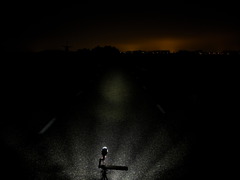
(original 14 Mpixel)
|
I decided to compare a bit on the side of the road with the Edelux to see how nicely the cool white and neutral white show objects beside the road (the 2nd Edelux shot is a bit overexposed as I pointed it too low):
The above pictures are really not that suitable to properly compare the light colour as it would be better to have the same light beam with different LED colours but along the with the various other pictures of LED colours and what you see with them that I made with some torches/flashlights, it should give a reasonable impression of how the cool and neutral white beams differ in how you see the road and what's beside it.
3. XM-L LED colour comparison and beam shape with various lenses
LEDs that I'm experimenting with:
- Triple XM-L 1A (bin T6)
- XM-L easywhite EZ E7: Warm white, nice for indoors. Too much emphasis on brown for outside though, not enough contrast between the tiles of a path and leaves that have fallen on it.
- XM-L 1A: Cool white: The standard problem of greens looking too much alike, and browns disappear.
- XM-L 2T: Cool white but a bit more green. Quite a bit better than 1A.
- XM-L 1D: Perhaps slightly better than 1A?
- XM-L 1A (T6): just a higher bin than the T5 above.
- XM-L E5 (4000K): Excellent. Looks slightly colder than the LF2XT flashlight (XP-E 4C ) which it shouldn't be. Perhaps because it's slightly more towards green? Or perhaps it's actually an E3 (5000K), that would explain a lot! I think I prefer the colour of the LF2XT to that of the E5.
- XM-L E7 (3000K): Almost the same as easywhite E7. Too warm, too much emphasis on brown, this means not enough contrast between greens and browns/yellows.
- XM-L E8 (2800K): Too warm, too much emphasis on brown, this means not enough contrast between greens and browns/yellows.
Lenses:
- Triple: Cute 3 XM-W (wide)
- Triple: Cute 3 XM-M (medium, +/- 12.5 °)
- Triple: Cute 3 XM-SS(medium, +/- 9.5 °)
- EVA XM-WW
- EVA XM-W
- EVA XM-M
- EVA XM-D
- Iris XM (8 °)
3.1. Pictures of the test setup
LiPo battery, h6flex, and XM-L LEDs:
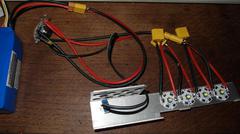
3.2. Wall shots (for the light colour)
Wall shots on a very white wall. Camera: white balance = 4600K.
Light sources: LF2XT (torch), 1A, 1D, 2T, E5, E7, easywhite E7, E8 (XM-Ls are bare, no lenses):
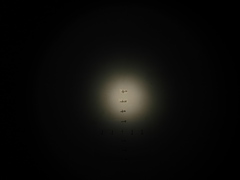
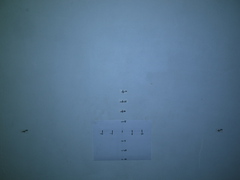
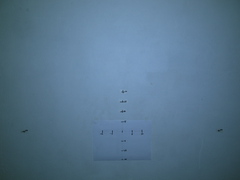
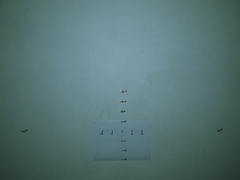
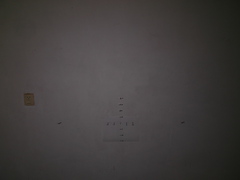
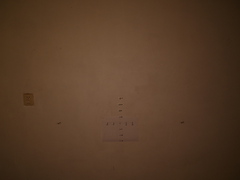
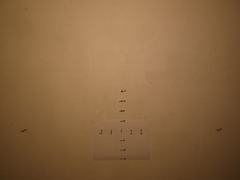
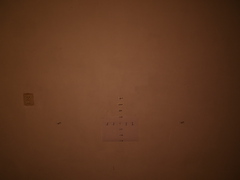
3.3. Garden pictures with green/flowers and shots of a tile path with leaves on it
In the garden, green with flowers. Camera: white balance = 4600K.
Light sources: LF2XT (torch), 1A, 1D, 2T, E5, E7, easywhite E7, E8 (XM-Ls are bare, no lenses):
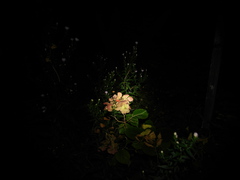
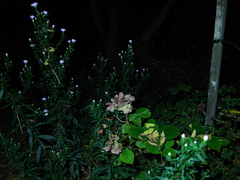
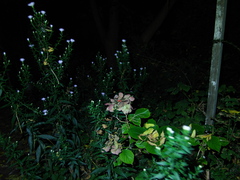
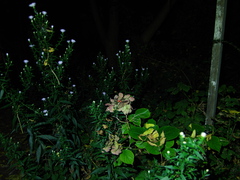
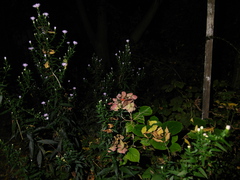
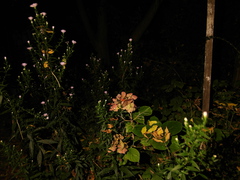
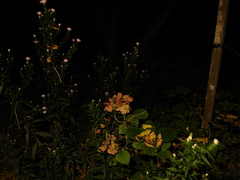
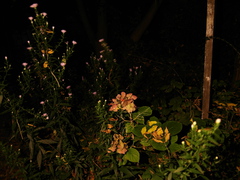
In the garden, path + stuff beside it + leaves on the path. Take note of the leaves and the brownish colours, especially the difference between the tiles and the leaves.
Light sources: LF2XT (torch), 1A, 1D, 2T, E5, E7, easywhite E7, E8 (XM-Ls are bare, no lenses):
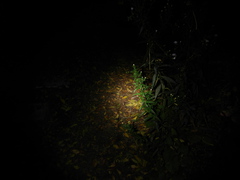
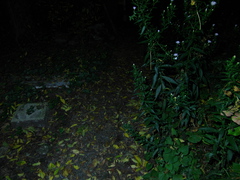
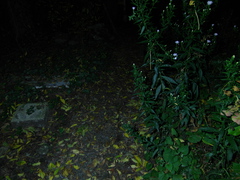
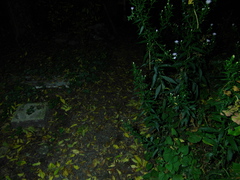
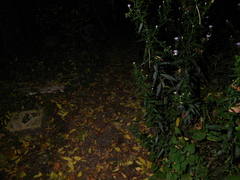
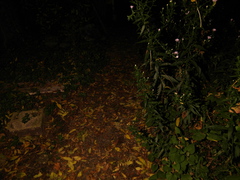
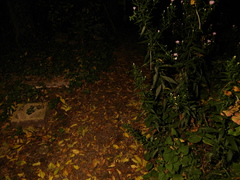
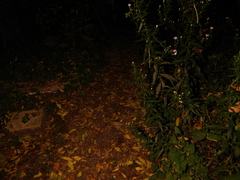
4. Colour comparison tests in fog using torches
The first test was done when I didn't have my new camera (at that moment this was the ST70) with me and will perhaps be redone with pictures next time there is dense fog. The second test gave enough information to confirm the results and by studying the pictures closely, the results of the first test in dense fog shouldn't be a surprise...
4.1. Colour comparison test in dense fog using torches (2010-9-21, night/very early morning)
Warm white is superior, and cool white is very poor under these circumstances. Warm white clearly showed the objects on or beside the road, at good distance. Cool white gave a hazy view, as the reflected light is similar in colour to the fog itself (which you can see at night as well from even the little light there is at that time) which means it looked to be even foggier than it was, and even more contrast was lost than cool white does under normal circumstances (so it's hard to distinguish objects in various colours from each other or from the fog).
4.2. Colour comparison test in less dense fog using torches (2010-11-1, night)
The following pictures were made a lot later on 1 November 2010, in less dense fog than on 21 Sept., on road 1, with torches using:
(1) XP-E WC cool white, (2) XP-E Q4 4C neutral white , (3) XP-G R4 5B1 neutral white (with a wide beam), (4) XP-G Q4 8B1 warm white:
1st set: torches were held underneath the camera, close to the camera lens:
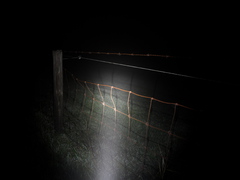
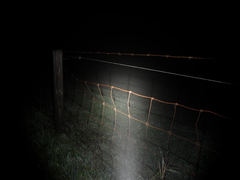
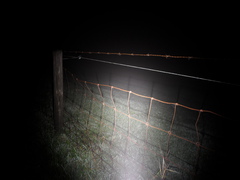
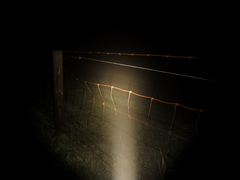
(14 M pixel images)
2nd set: almost the same conditions, torches as close as possible to the camera lens, underneath the camera:
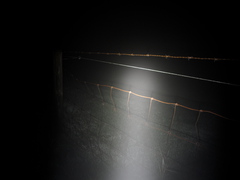
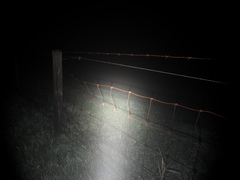
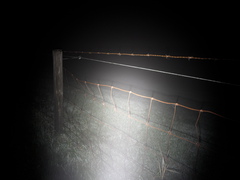
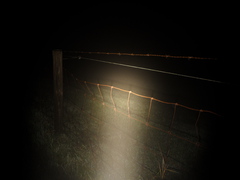
3rd set: torches held at arms length from the camera (ca. 60 cm):
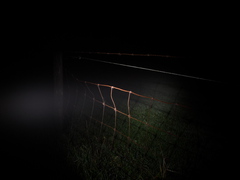
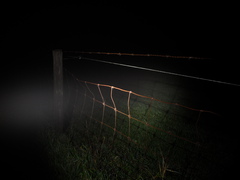
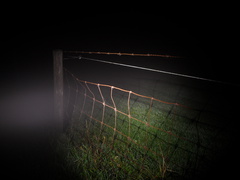
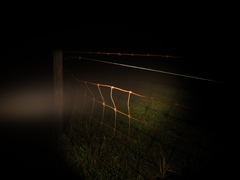
The effects aren't as dramatic as in really dense fog, but some things are clear:
- Having a bright lamp close to your eyes is bad
- Cool white is poor. Have a look at the pictures in set 2 in particular, and try to look at the grass through the white mist/beam. In the picture with torch 3 (XP-G R4 5B1 neutral white with a wide beam), despite the huge amount of light this torch produces in a wide beam, which means a large cloud in the picture, you can see the grass through that beam's cloud better than in the first picture (which is of torch 1, cool white). With torch 4, which is warm white, the grass can be seen even better.
- Wide beams are bad too, but only if the beam is close to you (you can see this in the 3rd set, where with torch 3, there is no mist that obscures the view, despite the wide/strong beam from that torch).
- Once you get a reasonable distance between a torch and the camera lens (say ca. 60 cm), there is no problem with light from the torch's beam reflecting from the mist back into your eyes. Even the wide beam of torch 3 doesn't hinder then.
On 17 Nov. 2010 I experimented with the distance from lamp (torch) to my eyes/camera and for a torch with wide beam: At about 35 cm away there was no fogginess ('wall of light') any more. I've made some pictures with the torch at a few cm, 10cm, 20 cm and 30cm from the camera lens but they are blurry so I will make new ones soon. On a previous fog-ride with the Philips SLD dynamo lamp I put my head fairly low, as close to the lamp as I dared when riding (about 45 cm from the lamp to my eyes), and there was no problem with any wall of light phenomenon.
(pictures to be added at a later date when it mists again, the ones I made on 17 Nov. were poor as I didn't have a tripod with me)
2022-11-24: Uploaded the pictures with a wide beam pocket light at various distances from the camera, as I never got round to making new ones, they are not great but give a good indication anyway of the wall of light phenomenon in this situation of a wide beam (not much change vs. a narrower beam):
Camera 30 cm from pocket lamp:
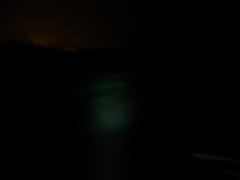
Camera 20 cm from pocket lamp:
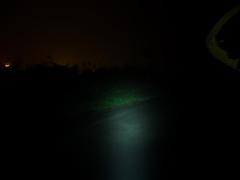
Camera 10 cm from pocket lamp:
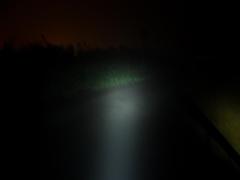
Camera 3 cm from pocket lamp:
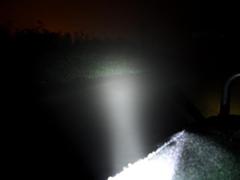
I will do the distance test with a more powerful torch or bike lamp in the future to see if that changes anything about the required distance from lamp to eyes before there's no hinder from the lamp's beam reflecting back into your eyes. Update: I've done this with a Lupine Betty in the mist. The result is that even with much more powerful lamp, from 60cm away there is no wall of light phenomenon, but at 30cm it wasn't all that bad. This shows that the earlier results for far lower power lamps holds up. If you keep the lamp about 60cm away from your eyes you will not notice any 'wall of light'.
The following were made on road 1, the fog effects didn't show much except when aimed further, so I decided to make these more to show what the side of the road looks like in all these LED light colours:
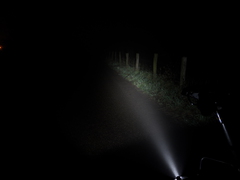
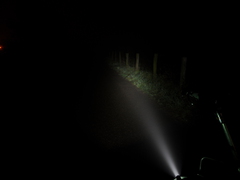
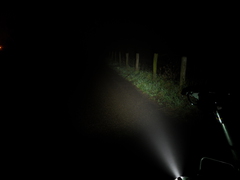
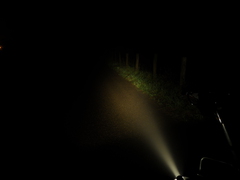
(14 M pixel images)
5. Colour rendition index (CRI)
An email about this subject made me put my thoughts about this in writing. I had already thought it out but hadn't written anything down and as I have now done it in an email, I might as well put those thoughts here too:
CRI = colour rendition index, and tells you how accurate (with a given method of adding deviations) the light is to that produced by black body radiation, where 100 = perfect, i.e. distribution of light is the same as that of a black body radiating heat/light. The CRI is, or rather can be important for accurate colour reproduction, but:
- I only deal with LED lamps as others don't produce enough light for the power (incandescent bulbs such as halogen), or produce horrible light (HID/Xenon).
- Those 2 above are also too fragile (short lifespan, HID can't do a lot of on/off cycles).
- CRI is similar for most LED types, about 75-80. There are some higher ones, but none of the big manufacturers seems to concentrate on this, large output comes first :)
- The CRI only says how accurate the colours are to a black body radiation at a given temperature (with a given way of adding/averaging deviations from the output to that of the blackbody at that given temperature) and not how accurate they are compared to sunlight (which is approximately black body radiation of 6500K depending on the precise conditions)... Incandescent bulbs are of course very close to blackbody radiation as they are hot metal that radiates away light. However, incandescent bulbs glow at far lower temperatures than the equivalent of the sun which is why they make everything appear yellowish. They do give a broad continuous spectrum of light which is why you don't get the effects of in particular cool white LEDs, which show all greens as almost the same colour. So, colour reproduction is bad compared to daylight, but you can very well pick out the differences in colours (in contrast to cool white LEDs) which is why some people still use them for MTB riding .
- LEDs usually have a big spike in the blue right before the light output drops off and then it slowly increases in the direction of red, see this picture of the XM-L series as an example which shows more emphasis on higher wavelengths in neutral and warm white compared to cool white:
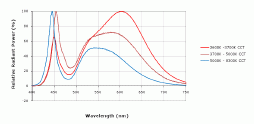
Now think about what this mean: If you use a LED with 6500K (daylight, overcast which should show all the colours as you are used to them), then it will be the awful blue light as in Xenon lamps and as in cool white LEDs. These do not work well to show the colours you see beside the road! And they do not work well because of their low CRI, too much light is just in a spike in the low wavelength area, i.e. blue.
So, you need to lower the colour temperature (neutral white LEDs, ca. 4500 K for example) to get good (or better) colour rendition of those colours you will usually encounter (green, yellow, brown, gray of the road etc.).
I just don't think taking CRI into account is useful at this point. If and when LEDs produce so much power that manufacturers will pay more attention to this it could be, or perhaps also not because you don't need high CRI if you produce the right colours for the objects/surroundings you normally see on/next to the road. So if the green/brown/yellow colours are fairly accurately illuminated as they are in daylight, then you really have what you need. And that was what I wanted to show on this page with LED experiments.
So, unless a LED has a horribly low CRI, I stand by my advice of a neutral white LED being the best choice (almost irrespective of CRI) to illuminate the road/trail such that the colours you will see are closer to how they look in daylight, and to give more distinction between the greens and browns which all just disappear in a single green colour (and a single near black colour for the dark browns) using a cool white LED.
Update 2024-1-26: The tests I did with high CRI LEDs the last few years confirmed this estimation:
You can improve colour rendition in 2 ways: 1. with a lower colour temperature and 2. with a higher CRI. The tests with a Nichia 519A 5700 K (in reality ca. 5300 K), which has 95+ CRI, showed that this is not as good as a neutral white ca. 75CRI LED of ca. 4000K for the purposes of seeing everything at night as well as possible and a bit for comfort too. 5300K is daylight which gives a too harsh contrast with darkness around you at night. With such a 4000K ca. 75 CRI LED colours are a bit more vibrant than with daylight which this 519A 5700K LED resembles, but that helps you make out everything such as different road surfaces. The optimal seems to be somewhere in 3500K-4000K with high CRI. Lower than that and everything looks too yellow. Higher than 4000K and there is not enough distinction in objects, which is especially noticeable when it rains, even with high CRI as I found with the Nichia 219B sw45k (4500K, slightly rosy, so negative DUV).
Test in very dense fog: high CRI 4000K vs. low CRI 4200K-4500K and low CRI cool white
2022-2-9: It was very foggy about a week ago, visibility was max. ca. 20-25m irrespective of what lighting I used. I was riding with the Spanninga Axendo 40 as my main bike lighting, and stopped to do a test of the high CRI torch IF25A with SST20 4000K 95 CRI (I think ca. 2500lm) vs. S2+ with XML-4C (in the region of ca. 4200K-4500K, and I think ca. 600lm) and of course compare these impressions with the cool white Spanninga Axendo 40 bike headlamp
I made a video (not yet uploaded), and it should show what I saw, which I will describe below:
The difference between a Convoy S2+ torch with XML 4C LED (should be in the region of 4200K-4500K) and a Sofirn IF25A using 4 SST20 4000K 95CRI LEDs was quite clear. With the SST20 LEDs I could see the things beside the road (grass, ground, i.e. yellows, browns and greens) far better than with the neutral white torch. Normally neutral white is good enough for a bicycle light, also in the garden, I found that the neutral white XP-G 5B1 and the neutral white XML 4C are very similar to what I see with the Sofirn IF25A in the garden under normal circumstances. The IF25A has a very nice colour rendition, my favourite of all LEDs I tried so far, much better than the LH351D 4000K in the Wurkkos FC11. I found that only within the house I really noticed the difference in the SST20 providing far more pleasant colours than the low CRI LEDs. Further, there is a difference in ability to see depth perception just as with cool white where you really lose depth perception almost completely outside in the garden when using cool white, whereas you see things as they are, where they are, with the neutral white low CRI LEDs that I tried. Comparing the high CRI neutral white LEDs to the low CRI neutral white LEDs I had already found a much smaller difference in depth perception, which was clear for example in some situations such as seeing depth behind a aluminium grid wire fan filter of my PC when shining the torch on it, whereas seeing depth of things close behind it was impossible with my low CRI LEDs. The effects everywhere compared to the XP-G 5B1 and XM-L 4C are subtle and mainly noticeable inside as there you usually have more variation in colours than in nature (except if you have a lot of flowers in various colours in your garden!).
for heavy fog (visibility was just 20-25m no matter what lighting I used, the IF25A (ca. 2500 lm estimated light output, round beam) could not penetrate farther than the Axendo 40 (ca. 100 lm cutoff beam) nor the S2+, all ended at about that distance, more light just didn't help at all) this was different. The almost white reflection off of all the things beside the road (which are then of course wet from the fog, i.e. giving similar issues as spotting things on wet roads for which cool white is the worst) made it far less clear where the road ends. With high CRI the colours were far clearer.
This test was also interesting for a 2nd wall of light phenomenon which is caused by non-cutoff beams at a certain distance. This looks like a wall of light which is positioned at about the end of where you can see (make out) the road and is caused by the round beam's light going upwards. I felt it didn't impair vision as the wall is at the edge of where you can see things with a non cutoff and cutoff beam, so there was no change between any of the lights, from the Axendo 40 cutoff at ca. 100 lm cool white, to the IF25A with ca. 2500 lm neutral white high CRI round beam), all giving about 20-25m visibility.
The original wall of light is one that is caused by the light source being too close to your eyes, which in this case of very dense fog was a bit more than the previous times. The effect began at with the torches at ca. 50-60cm from my eyes, whereas with lighter fog it was ca. 30-40 cm.
So in heavy fog the IF25A due to the light colour, not due to the amount of light, is far better than the low CRI XML. This was an exceptional circumstance, so for normal use I'd be happy with 4000K neutral white light, but optimal would be high CRI neutral white.
I bought a Sofirn IF25A which uses 4x SST20 LEDs at 4000K with 95 CRI. The light itself is fantastic compared to the flashlights I've been using from standpoint of light output, but also the interface (anduril) is much better.
It has some flaws, for example I got into stepped ramping a few times which I don't like. Anduril should have NOP sequences so that in particular you don't inadvertently switch from ramping to stepped and reverse by issuing 3 clicks whereas you only wanted to do 2 clicks to go to Turbo. This happened to me multiple times so 3 clicks should be a "No operation" (NOP) in an interface which uses a lot of 2-clicks. In any case it is better than any lights with annoying flashing modes that are directly included. With the Convoy S2+ 3/5/ mode I regularly end up in the flashing mode group, who the fook uses that nonsense? To resist against attackers? Who has ever used that? Here is what would happen if I needed that:
- Please Mr. Attacker, let me get out my flashlight!
- A few seconds later: Oh, I found it, but how to get to the strobe mode? Please wait a bit!
- A few seconds later (after all, it is a stress situation!): Yes, I remember now how to put it into flashing mode, I will do that now.
- A few seconds later: Ok, Mr. Attacker, please continue!
Useful? I don't think so!
I have a Sunwayman V20C-Y that has a very useful ring to set the light output and might even be useful for defence with the ring as strobe is at the very end (so, quickly to set). Its light colour was rather greenish so I was thinking of replacing the LED with say an XML 4C but it got defective from water ingress (from just cleaning it)...
In comparison the IF25A has far more light output and the up/down ramping is about as good as the ring on the V20C, so it is a good replacement for daily use.
Of the torches I used for comparisons in the past:
- All the Trustfire F23s are dead
- The Trustfire F22 is unreliable
- I sold the LF2XT which had the best light colour so far, it was stated to be 4C (ca. 4300-4500 K but I think it was warmer as the sales text that I found in my email archive stated warm/neutral. This would explain some of the results...
- I put the XPG 5B1 (i.e. somewhere in the range of ca. 4100-4300K, I bought this LED from Cutter so its colour range is almost certainly correct) into a Ferei mini800 torch.
Newer ones:
- Convoy S2+ XM-L ca. 3000K (it was stated to be 5B but it's far warmer!)
- Convoy S2+ XM-L ca. 4000K (it was stated to be 4C which would be ca. 4300-4500K, but it's warmer, ca. 4000K)
- IF25A 4x SST20 4000K 95 CRI
- Exposure Strada 1200 (1200lm, cool white), as a generic cool white reference.
- Silva head-mounted torch, with 2x 18650, ca. 600 lm, cool white,
Testing: Ideally there should be flowers in the garden but that will take a while, so for now my impressions as best I can do:
Somewhere in the range 4000-4500K is optimal for a bicycle lamp from my testing , as I noted in my lighting analysis section, and in this test I want to see what the high CRI output adds. The result so far confirms my view of high CRI: It is better, but it doesn't add much. The big jump is going from cool white to neutral white. Possibly the lower end of the range 4000-4500K is better? I may buy a light such as the Emisar D4V2 with one of the new types of Nichia 4500K high CRI LEDs (E21A R9080) to test this further.
Experiences: So far what I see with the SST20 4000K vs. XP-G 5B1 and XM-L at ca. 4000K (colour temp. looks the same as the SST20 4000K) is similar to the difference of cool white vs. neutral white, in that high CRI adds a little bit of vibrance, depth, and the others with low CRI 'lose colours', you feel that you miss something when directly comparing them lighting up the same scene. But this effect is small, far smaller than the difference between a cool white low CRI vs. neutral white LED as I noted immediately the first time I did these types of tests. In the latter case all the greens become one green ocean, browns disappear into almost black, yellows are not shown correctly and this loss shows in reality in a loss of depth perception, and you 'see' this in beam shots too in that the picture looks 'flat'. So this confirms my estimation of the importance of CRI for the effectiveness of a bicycle light (or indeed any vehicle light) being fairly low, as I stated in the previous section, which I wrote in response to an email on this topic many years ago.
More tests comparing e.g. the rendition of yellows
I made a video but need to test whether the colours are correctly (well, well enough) rendered in the video, which is a big problem in showing what you see in reality because of the limitations of camera sensors, esp. as I used the older S5 phone for this. I may have to do it with the RX100.
I compared LEDs of 1. 6000K, 2. ca. 4000K neutral white (XP-G 5B1), 3. 4000K neutral white 90 CRI LH-351D, 4. 4000K neutral white SST 20 95 CRI. The result is that between each of them there is a clearly visible difference of increase of vibrance of the yellow. It looks most washed out with 6000K and most vibrant with the SST20 4000K.
Situations where low CRI LEDs and different tints of LEDs may be useful, in the house and as a bicycle light
I discussed this long ago with a friend in relation to the LED light colour used in the Edelux and other headlamps. The comment he made was that cool white could be useful as a way to increase contrast between road and side of the road, and that possibly the greenish LEDs that were used in the Edelux were specifically chosen for this purpose. I don't think that that is useful, even though in the house there are some examples where I could use various LED light colours such as to identify where I had painted the walls, and where I still needed to apply paint. The Edelux that I used for my tests and beam shots isn't greenish, but 2 others I bought some months later to mount on other bicycles, were quite greenish... However, you don't need more contrast, you need to properly see the road! And with LED lights being able to put out enough light to actually illuminate the road in a useful manner, that should be the goal, not to give a harsh contrast so that you know you are on the road vs. on the side of the road.
Overview of my use of pocket lights (torches/flashlights)
I moved this to the new pocket light section in the reviews...
In some places mention is made that a beam with cutoff such as car headlamps have, and that all approved lamps for dynamos in Europe have, is better in fog as you will get blinded by a wall of light otherwise. I tested this in autumn 2009 in fairly heavy fog at night, by using a Schmidt Edelux and while cycling I tilted the lamp up and down many times to see what difference it makes. When aiming high a very large amount was going up into the air. The results were clear: There was almost no difference in how well I could see the road (the light scattering when the lamp was pointed up, gave more light on the road and all in all the difference between all the positions, in what one can see of the road, was very small), and I did not get blinded by light scattered by the fog. A single 200 lumen lamp is therefore in no way enough to cause this wall of light phenomenon.
Update 2010-2-6: Again in fairly heavy fog at night, I tested with a torch (flashlight) that gives the same amount of light as the Edelux (both using Cree Q5 LEDs) but of course has a symmetric (circular) beam. I then observed what might be called a wall of light. It wasn't a wall of light though, but a lot of light being reflected into your eyes from the beam just after it leaves the lamp (this gives the same problem as when a car approaches you from the opposite direction: you don't see much at all except the light from the car's headlamps). I then proceeded to try angling the lamp up and down, and when angling down the problem got naturally less as the road close to me reflected more light back to me, so even though my eyes were adjusted to the large amount of scattered light from the fog, I could see the road clearly. But of course, the road was only lit up to close distances...
The next test was to put the torch (flashlight) lower. I had kept it at chest height at first, and moving it down to handlebar height it was already much better. There was not a lot of fog-scattered light that made my eyes adjust to a higher brightness, and I did not need to angle the lamp down to be able to see the road better. Lowering the torch (flashlight) still further to fork crown mounting height (where my Edelux is mounted), it was even better, and there wasn't any influence of the scattered light on the visibility of the road. This confirms the results of my earlier test with the Edelux: It just doesn't matter what beam shape a lamp has, the 'wall of light' phenomenon is almost entirely related to the light beam's distance to your eyes (at least for a 200 lumen headlamp). This means, the best mounting position, in case of fog, is as far away from you (i.e. as low and as far forward) as possible.
In section 4.2 I have described some more experiences which confirm all this.
And finally: The tests at the end of 2010 with the Lupine Betty 2011 at full power in the fog made it clear that the amount of light of the lamp is not really an issue in the 'wall of light' phenomenon, the results of the earlier tests with the Edelux and a torch were confirmed: the distance to your eyes of a reasonably bright light source is by far the biggest component of what causes a 'wall of light'.
It was misty again in the night of 17 Nov. 2010 and I was up early, so I did do tests with mist lamps: 2 torches mounted near the axle of the front wheel.
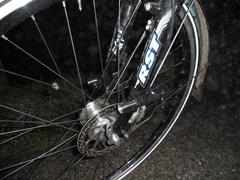
Result: Doesn't add anything over a Philips SLD. The broader beam of the one on the right hand side was completely useless. The light colour (the one on the right was neutral white, the one on the left warm white) also didn't help. So, the concentrated beam of bicycle lamps with cutoff, really make it so that you can see farther ahead with them than with a standard symmetric beam, also in fog, and using a symmetric beam as fog lamp low to the ground certainly doesn't help.
Perhaps an asymmetric beam would help and I will try this next time there's fog with an Edelux or Philips SLD mounted very low, near the axle of the front wheel.
I've modified a Lumotec oval senso plus, which originally uses a halogen bulb with which you can hardly see anything, by putting a rectifier, smoothing capacitor of 4700µF and Cree XP-E R2 cool white LED into it. Actually, some of it is not inside it, but hanging outside for now which is why it's a Frankenlamp :)



Experiment 1: I used a standard bridge rectifier, no Schottky diodes (which have a very low voltage drop, but are probably overkill when using 1 LED), as I just wanted to test if/how well the LED modification works. At first I didn't use a smoothing capacitor which gave very flickery light at low speeds. Also for some reason the Lumotec's standlight didn't work in that case. I was unhappy with the light output, it was too unfocused, not a good illumination of the road surface. Another point that's interesting is that the vibrations in the bike from the dynamo hub started earlier (ca. 17 km/h) and I could feel them better, than when I added a smoothing capacitor. This means the electronics in a LED lamp can have an influence on vibration in the bike. The influence of the electronics on vibrations is probably also why I didn't get more vibrations with the Ktronik triple-XP-G on the dynamo hub, than with the Edelux. In particular it wouldn't surprise me if the tuning capacitors (with which one can select the power curve from the dynamo hub), have an influence on the vibrations...
Experiment 2: I then experimented with the LED connected to a power supply, and manoeuvred the LED such that it was near the focal point for the reflector, and directed such that most of the light went downwards. Projected on the wall, the lamp gives stray light and a smallish blob that will be the main beam on the road.
After adding a smoothing capacitor (1000 µF), I made another test ride and the result was much better. The flicker is a bit stronger than what one usually gets with lamps attached to a hub dynamo, so not too bad but it could be better, there's a lot of light where I want it (on the road instead of scattered all over the place) and the standlight now works...
In the first picture you see a bit of the aluminium plate onto which I glued the LED, sticking out (the plate is bent into a U-shape, and one side of that goes into the reflector housing).
The result is reasonable: I get a lot more light on the road than with the original halogen, I also get light at lower speed, but there is still too much spill light going upwards so when I ride on a street with trees beside it, they are noticeably lit up... I will try to improve on this by reverse mounting the LED or just increasing the angle that it's currently at.
Experiment 3: Instead of aluminium plate I used thin aluminium as used in some baked products you can get in the supermarket. This gives good enough cooling and allows me to deform and thus position the LED where I want it. Reverse mounting the LED (so no light from the LED leaves the front plastic directly) doesn't work well. I can't get the light focused enough.
Experiment 4: Same setup, but slight changes to the position which is now similar to that used in experiment 2, but adjusted a bit to give an as narrow slit of light on the wall as I could when using the power supply on the LED. This gives me a very good beam, about as wide as the Edelux, a bit less bright and not as much throw. Too much spill light gets into the air and I doubt it would be StVZO approved with this lighting pattern, but it's all an experiment anyway. I wanted do some tests as to how much oncoming traffic is hindered by the direct light from the LED, but I didn't get round to it.
Experiment 5: Same setup with the thin aluminium foil but here I use an XP-G R4 5B1 (neutral white). It was fiddly, couldn't get it focused as tightly as the XP-E R2 cool white (yes, I've encountered the XP-G focusing problem!) but it puts out a very nice beam which, if I didn't have the Edelux, I would be really happy with. The Edelux is brighter and has a bit better beam but I do have a much nicer neutral white illumination of the road and what's beside it, plus more near-field light. So I'd say experiment succeeded, also because I now pointed the LED downwards instead of up with which I could also get a hotspot on the wall (hotspot on the wall = light beam on the road) but all the spill light goes downwards. This also results in very good near-field illumination. And I'll say it again: I really like neutral white instead of cool white!
After this I did tests on wet roads with this lamp which confirmed the results of my torch light colour test. See earlier on this page. Btw. Cooling of the LED didn't appear to be a problem even though it's just on a small piece of thin aluminium... Perhaps because the lamp is partly open and plenty of air flows round it to cool the aluminium.
Last modified: 2024-1-26












